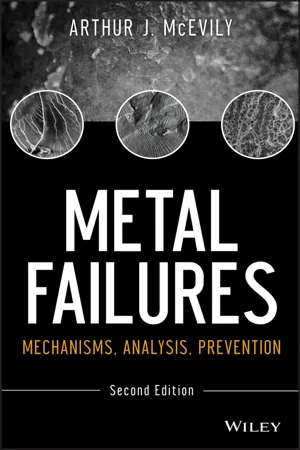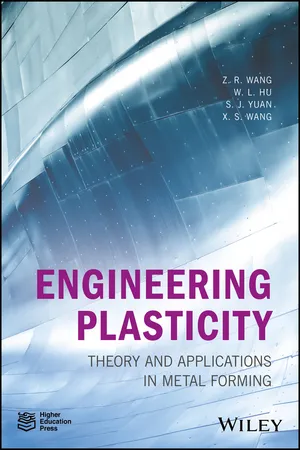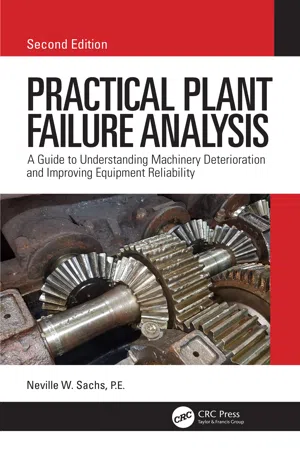Physics
Yield Stress
Yield stress refers to the point at which a material undergoes a permanent deformation or changes its shape under stress. It is the stress level at which a material transitions from elastic deformation to plastic deformation. Yield stress is an important property in materials science and engineering, as it helps determine the strength and durability of materials under various conditions.
Written by Perlego with AI-assistance
Related key terms
Related key terms
1 of 4
Related key terms
1 of 3
6 Key excerpts on "Yield Stress"
- eBook - ePub
- Ian M. Ward, John Sweeney(Authors)
- 2012(Publication Date)
- Wiley(Publisher)
Figure 12.8 (a)). Because this stress is achieved at a comparatively low elongation of the sample, it is often adequate to use the engineering definition of the Yield Stress as the maximum observed load divided by the initial cross-sectional area.FIGURE 12.8 (a) The Yield Stress is defined as the load divided by the cross-sectional area at the point A. (b) The Yield Stress is defined as the stress at the point B. (c) The Yield Stress is defined as the stress at the point C.In some cases, there is no observed load drop and another definition of Yield Stress is required. One approach is to determine the stress where the two tangents to the initial and final parts of the load–elongation curve intersect (Figure 12.8 (b)).An alternative is to attempt to define an initial linear slope on the stress–strain curve and then to draw a line parallel to this, which is offset by a specified strain, say 2%. The interception of this line with the stress–strain curve then defines the offset or proof stress, which is considered to be the Yield Stress (Figure 12.8 (c)).12.2 Ideal Plastic Behaviour 12.2.1 The Yield Criterion: General ConsiderationsThe simplest theories of plasticity exclude time as a variable and ignore any feature of the behaviour, which takes place below the yield point. In other words, we assume a rigid-plastic material whose stress–strain relationship in tension is shown in Figure 12.9 . For stresses below the Yield Stress there is no deformation. Yield can be produced by a wide range of stress states, not just simple tension. In general, it must therefore be assumed that the yield condition depends on a function of the three-dimensional stress field. In a Cartesian axis set, this is defined by the six components of stress, σ 11 , σ 22 , σ 33 , σ 12 , σ 23 and σ 31 - eBook - ePub
Metal Failures
Mechanisms, Analysis, Prevention
- Arthur J. McEvily, Jirapong Kasivitamnuay(Authors)
- 2013(Publication Date)
- Wiley-Interscience(Publisher)
Lüder's bands. At a strain of the order of 0.01, the test section will be completely filled with these parallel bands, and the end of the lower yield level behavior is reached. Further straining results in the interaction of dislocations, and as a result, strain hardening develops. The strain hardening is manifested by an increase in the stress required for further deformation until the ultimate tensile stress is reached. Thereafter, the stress drops until the breaking stress is reached, and the specimen fractures. It is noted that three instabilities develop during the course of a tensile test of a low-carbon steel. One occurs at the transition from the upper to the lower yield point, the second occurs at the maximum stress, and the third occurs at the breaking stress. The breaking stress is not a true material property, but is a reflection of the testing machine stiffness that determines its ability to shed load in the latter part of a tensile test. Under dead weight loading, for example, a type of loading corresponding to zero stiffness, the breaking stress would coincide with the ultimate tensile stress. On the other hand, in a very stiff machine, it is possible to decrease the breaking stress to a very low value.The upper and lower yield levels characteristic of low-carbon steel are not observed in most other alloys. In order to define a yield strength in such cases, an offset method is used in which a line is drawn parallel to the elastic loading line but offset from it by a specified amount of strain such as 0.002 (0.2%). The yield strength is defined as the point at which this line intersects the stress-strain curve.In the mathematical treatment of plastic deformation, certain simplifications are made that reduce the complexity of the stress analysis. One basic assumption is that the volume remains constant, that is, . This is a reasonable assumption since the plastic deformation process is a shearing process involving the sliding of one element of material over another without a change in volume being involved. The dilatation is given as3-15For plastic deformation, is zero, since . In plane-strain with equal to zero, it follows that . There is only one independent component of strain in plane-strain plastic deformation, since the diameter of the Mohr circle is given as the difference between these two strains. Similarly, if work hardening is neglected, by setting the maximum shear stress in the plastic region equal to , a material constant, there remains only one independent stress.The value of Poisson's ratio for purely plastic deformation can also be evaluated, making use of the assumption that is equal to zero. In a tensile test, the lateral strain ; hence . For constancy of volume, , and therefore . (Note that in the elastic range where - eBook - ePub
Art Conservation
Mechanical Properties and Testing of Materials
- W. (Bill) Wei(Author)
- 2021(Publication Date)
- Jenny Stanford Publishing(Publisher)
Fig. 2.11 , if the spring is overloaded, it will only return partially (the elastic part). (Note that the analogy of the atomic bond does not hold here. The explanation for this can be found in most materials science textbooks and is beyond the scope of this book.)Figure 2.13 Definition of the Yield Stress, σy and plastic deformation, εp . Note that this diagram is a simplified version of Fig. 2.8b .Notice that the stress-strain curve for a metal does not actually have a clear point which can be defined as the beginning of plastic deformation and the Yield Stress, σy . International agreement has set σy as the stress at which 0.002 or 0.2% permanent strain remains when the specimen is unloaded. One will therefore often see the symbol σ02 instead of σy .As the stress increases, the amount of plastic deformation will increase until the stress reaches a maximum at a level known as the “ultimate tensile strength,” σUTS . σUTS is none other than the material strength. The corresponding strain at failure is known as the fracture strain, εf , see Fig. 2.13 .As we noted in the previous section, the curve actually bends downwards to a lower stress level before reaching the fracture strain. This odd bend is a result of the fact that in engineering, the original area of the specimen, A0 , is used to calculate the stress using Eq. 2.3, no matter what the force is. However, if a rod is loaded with a tensile force as shown in the schematic drawings, the rod will have to get thinner as the force increases. This is known as the Poisson effect, and is purely the result of the concept of conservation of volume. You cannot make something longer and keep the other dimensions the same. You actually can see the result of this effect with large wall tapestries which are only hung along the top (see Fig. 2.14 ). The material near the top is thus carrying all of the weight of the tapestry and is strained downwards (tensile) the most. In order to conserve volume, the tapestry must therefore shrink parallel to the top edge. As a result, the sides pull in slightly and there is wrinkling at the bottom (arrows in Fig. 2.14 - eBook - ePub
Engineering Plasticity
Theory and Applications in Metal Forming
- Z. R. Wang, Weilong Hu, S. J. Yuan, Xiaosong Wang(Authors)
- 2018(Publication Date)
- Wiley(Publisher)
Since this yield criterion did not use the experimental result at the pure shearing stress state to characterize its predicting capability, the use of different values of n will create the biggest deviation at this stress state. However, in common applications featured by the absence of superimposed pressure, adoption of or would not have remarkable implications on the predicted results. Figure 4.13 Yield loci with different material properties with. 4.2.3.2 Stress-Type-Caused Effects Understanding the stress-type-caused effects on the material yield can be well acquired by dint of examining the profile of yield locus on the π plane or a plane parallel to the π plane because of there being a close relationship between the locus shapes and the effects. To do this, turn Equation (4.18) into 4.32 where ρ is the radius of intersection in a polar coordinate system (see Figure 4.14 a) with the angle θ denoting a certain stress type. For example, in the range of (principal stresses), means, denoting the states of simple tension, plane strain and simple compression, respectively. Figure 4.14 Yield loci on the π plane: (a) with a changing, (b) with a changing. For different material properties, there are two extreme conditions that meet. Also, corresponding to the conditions, we have two hydrostatic stresses 4.33 When the hydrostatic stress reaches either the maximum σ M (Max) or the minimum σ M (Min) it responds to. Some materials may have a relatively large absolute value of σ M (Min). Their yielding strength is always likely to increase with an increasing superimposed pressure. In such cases, we have. With the hydrostatic stress, the feature of yield locus on the π plane helps us understand the dependence of the material yield on the stress-type-caused effects. Figure 4.14 presents some yield loci, which show that their profiles vary with the changing experimental results or - eBook - ePub
- Sir Alan Cottrell(Author)
- 2019(Publication Date)
- CRC Press(Publisher)
eqn. 21.3 there is a sharp change of slope at the Yield Stress, the ultimate tensile stress can coincide with the Yield Stress. The instability then sets in as soon as the metal becomes plastic. There is no uniform plastic deformation, only necking. This condition, which can exist in metals excessively hardened by cold working or precipitation hardening, is dangerous in thin tensile members used in structural engineering because plastic deformation then leads immediately to localized failure at very low overall elongations even though the metal may rupture in a fully ductile manner. The danger is aggravated in some cases by effects of high rates of strain which usually develop in such regions of localized failure and by the tendency of some metals in such circumstances to change to a brittle type of failure. A high ratio of Yield Stress to ultimate tensile stress is thus to be avoided in metals for structural engineering.21.2 The Yield Stress
The typical commercial metal contains inside each grain a network of dislocation lines and a host of other irregularities, e.g. foreign atoms, precipitates, vacancies, small-angle boundaries, that can act as obstacles to dislocations. There are also often places on the grain boundaries from which dislocations can be released into the grain fairly readily. There may additionally be local groupings of dislocations created round large foreign inclusions by thermal shrinkage strains.Above a certain level of applied stress, some of these various dislocations are able to move between obstacles to an extent which is visible in, for example, the electron microscope. This does not represent general yielding, however, but a stage of ‘pre-yield micro-strain’ in which certain dislocations are able to move, either because the applied stress is enhanced by local self-stresses or by stress-concentrating features such as notches and sharp edged foreign inclusions, or because such dislocations happen to be unusually free from obstacles or lie in very favourably oriented grains. The overall plastic strain produced by these localized movements remains smaller than or comparable with the elastic strain, however, until the general Yield Stress is reached. Since the applied stress has to climb from its ‘pre-yied’ value to the Yield Stress within this narrow range of plastic strain, this preliminary plastic stage seems, on the stress-strain curve, to be a stage of very rapid work hardening.General yielding is certainly possible at a stress at which average dislocation sources (e.g. Frank-Read sources) can create slip bands in average regions of the metal. We may thus expect the general Yield Stress σy - eBook - ePub
Practical Plant Failure Analysis
A Guide to Understanding Machinery Deterioration and Improving Equipment Reliability, Second Edition
- Neville W Sachs, P.E.(Authors)
- 2019(Publication Date)
- CRC Press(Publisher)
3 Materials and the Sources of Stresses- A. Stress, Strain, and Material Strength
- B. Mechanical Stress
- C. Thermal Stress
Some very basic failure analyses can be accomplished without truly understanding the effects of various stresses and the materials they act on. Unfortunately, as failures become more complicated, this lack of knowledge almost always leads to serious errors and, when one starts looking into more costly or more complex failures, the need to understand exactly what is happening is incredibly valuable.Stress causes parts to bend or break, but all materials don’t react in the same manner. In the real world, a good understanding of stresses and their effects on materials is crucial to accurate failure analysis. (For example, doubling the load on a beam could cause it to deflect twice as much or it could cause an immediate catastrophic failure. But the effect of doubling the load on a rolling element bearing is that its life will be cut by a factor of eight to ten.) In this chapter, we’ll discuss some of those basic definitions and concepts.Stress
When a load is put on a part, the part is stressed . Figure 3.1 shows a block with a cross-section area of 645 mm2 (1 in2 ). With the load of 50,000 N (11,240 pounds), the resultant tensile stress is 77.5 MPa or 11,240 lbs/in2 .In this example, the block is axially loaded and the piece is in tension . In a similar manner, reversing the forces shown here would put the piece in compression. To calculate the magnitude of the stress in the block shown in Figure 3.1 the formulas = p / ais used. In this equation s is the pressure or stress (in MPa or pounds per square inch), p equals the load (in newtons or pounds-force), and a is the stressed area (in square mm or square inches).If the same block were to be subjected to a bending load or a bending moment the stress would be very different as seen in Figure 3.2 . The block in Figure 3.1 is subjected to pure tension and the stress is uniform across it but, as shown in Figure 3.2
Index pages curate the most relevant extracts from our library of academic textbooks. They’ve been created using an in-house natural language model (NLM), each adding context and meaning to key research topics.
Explore more topic indexes
Explore more topic indexes
1 of 6
Explore more topic indexes
1 of 4





